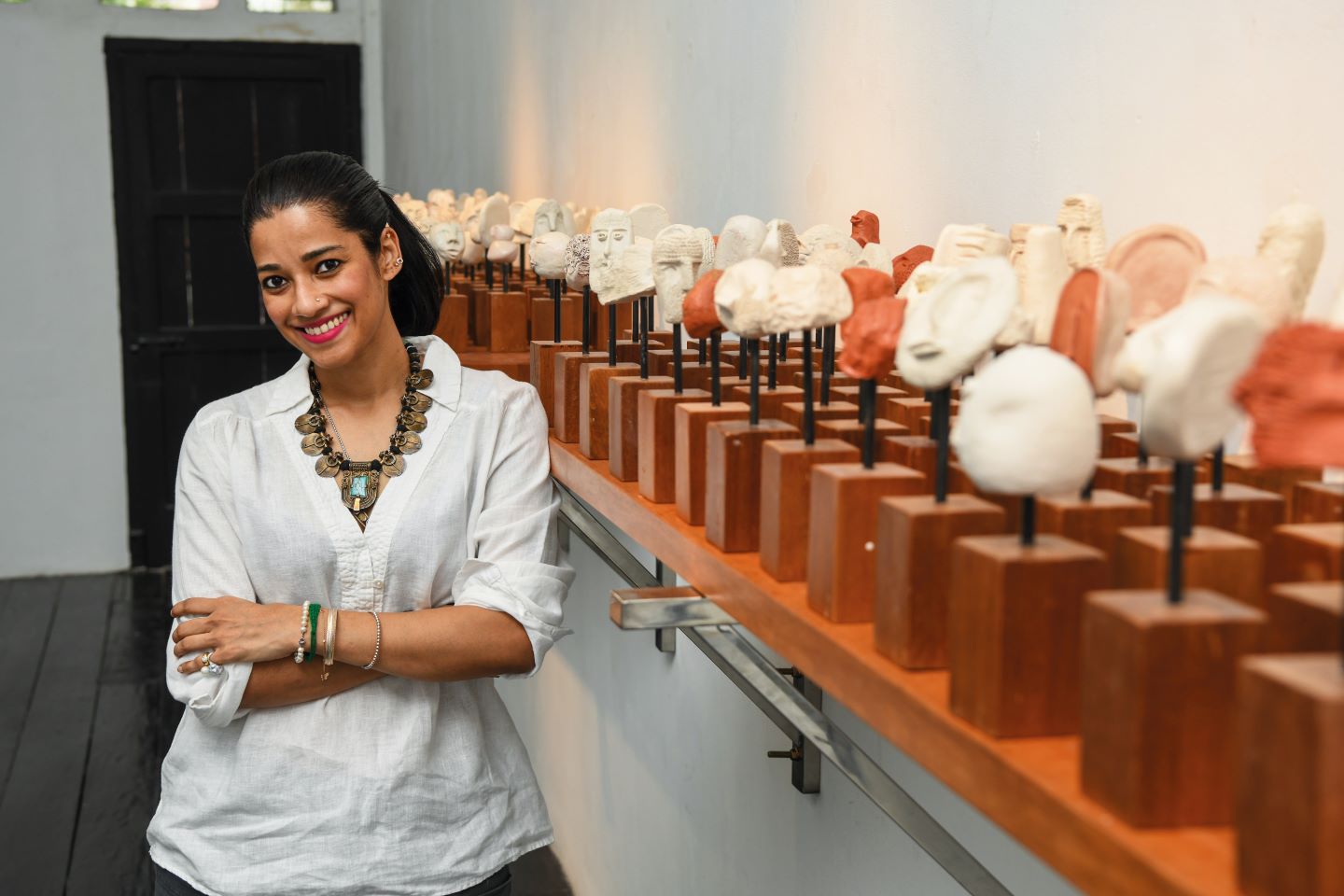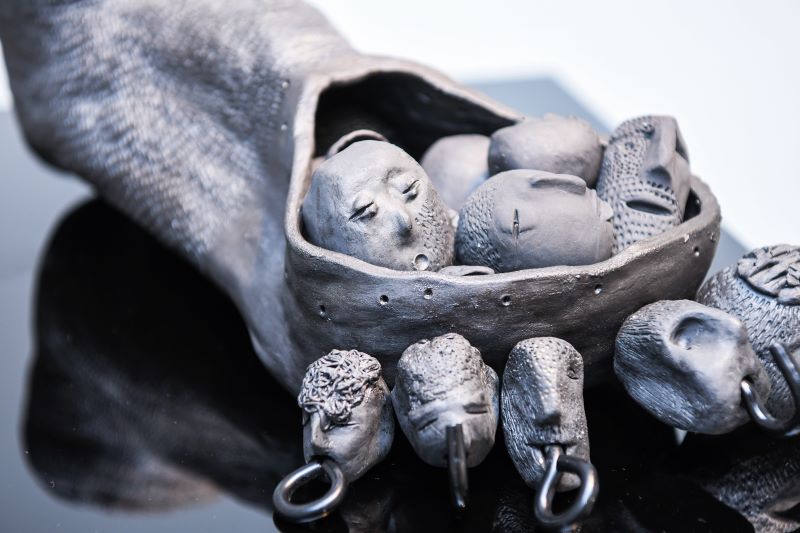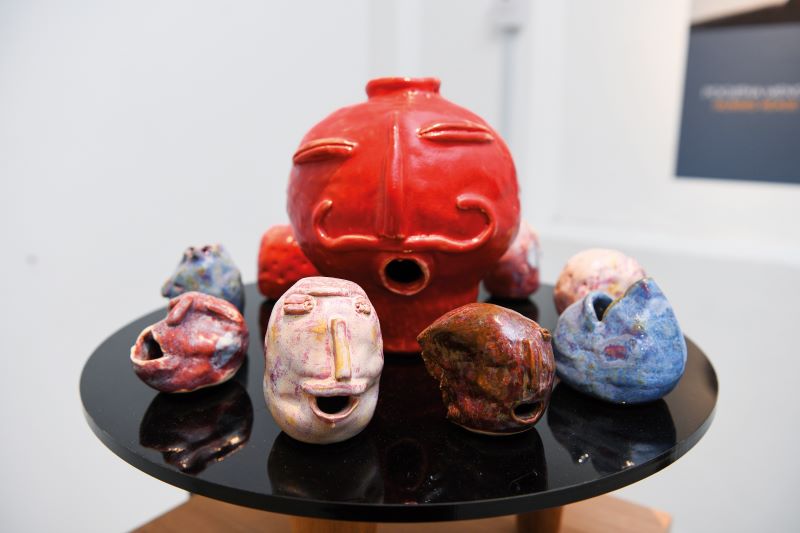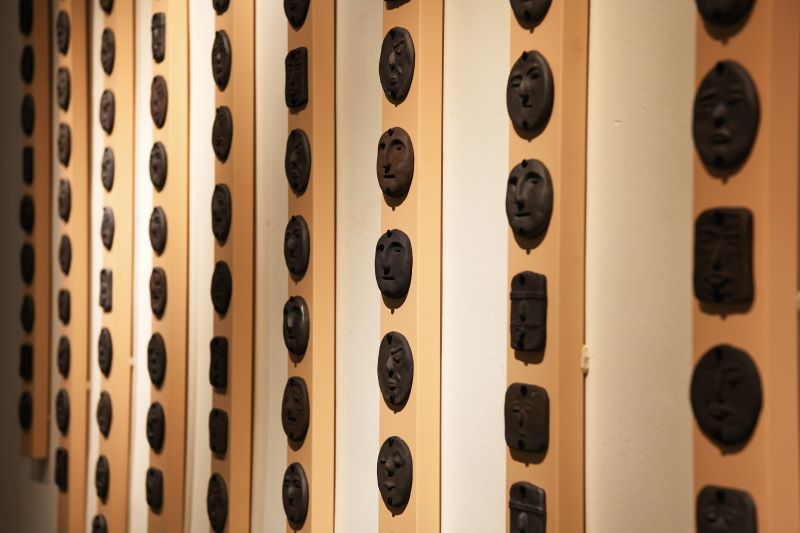
For Poojitha, what began as simple play has morphed into a passionate discovery of 3D forms and shapes that double as visual commentaries (All photos: Low Yen Yeing/The Edge Malaysia)
Multiple dialogues going on in Poojitha Ravi Menon’s head led her through the mental and emotional turmoil that shook her to the core after an early-stage cancer diagnosis in mid-2019, and the complications she faced post-op.
“A lot of the time, the heads communicating with each other were just me talking to myself,” says the visual artist, who found a new voice when she began transmitting those conversations in her mind onto clay.
Talking Heads, “a sculptural autobiography” of the time Poojitha was going through her major life experience, opened at ArtVoice Gallery in Kuala Lumpur on March 26. The exhibition is a sharing of her journey into clay, how she started, where it has taken her, and how it helped her heal.
“When I thought I was lost and alone, the talking heads were a sculptural witness to moments of knowing every idea that came to me was a solidified connection with the divine power, and that I wasn’t alone in my creative and life journey,” she recalls.
What began as simple play, with her letting clay give life to spontaneous ideas, has morphed into a passionate discovery of 3D forms and shapes that double as visual commentaries on people and everyday topics, from family to current affairs, myth, folklore, Indian mythology and Asian antiquities.
Translating into clay what she sees or something that affects her is a reflection of the way the mind works. Hence, the ‘heads’, she explains.
Clay takes her back to the earth, a reminder of how she tried to reconnect with her base feelings three years ago. “It started as a very cathartic healing medium … I needed something that used my hands and to mould. The whole process is intuitive and clay decides [the final outcome].”
Poojitha sees that soft, pliable lump as female and hopes it remains a medium through which she can express her ideas, no matter how crazy some are. “She is a hard taskmaster and temperamental, yet she sets me free. Maybe it’s something to do with my work being so raw and guttural.”
An idea can pop up at the weirdest time and — again the feminine pronoun — “She is fickle. If you don’t catch her, she goes off to the next mind that’s available. What triggers the ideas, I really don’t know.”
What this artist knows for certain is that she wants to work with clay for the rest of her life. But she will add other elements, such as neon lights, cement, acrylic and rattan to her abstract, hand-crafted pieces.
Poojitha is not bound by underlying themes, preferring to turn to current affairs, societal norms, daily life or perhaps a discussion with someone for inspiration. A lot of the time, the ideas that struck her were very organic and there was nothing she could do but sketch them out and sculpt them. “There was no way you could guess the final product.”
The seed for one creation titled Mother came to India-born Poojitha in her dream. She got up, made some sketches and went back to sleep. She then created Daughter, inspired by her own relationship with her offspring, followed by The Forgotten Female Spirit, as a continuity of all three. The last is special, she adds, because “it speaks about the umbilical connection we still have with our grandmothers”.
Sculpting little heads may look like toying with playdough but it is an art that requires speed, patience and care. Plus, proper areas for wedging (kneading the clay to remove air bubbles and obtain a homogenous mass) and moulding.
There is a lot of muck around the work stations, and ventilation is vital because of the dust particles flying round. The fan has to be at a minimum speed — no air conditioning — to prevent the clay from drying too fast or it will crack. Hollowed-out sculptures break easily, not to mention the sculptor’s back, from hunching over the workbench as she sculpts.
20230325_peo_poojitha_menon_42_lyy.jpg

“I cannot grow my nails, but otherwise, it’s all fun,” says Poojitha, who is “a mess” at work. On the plus side, few rules hold her back and anything can serve as a tool, from a sponge to whatever else is in the home.
Most of her sculptures are black, the better to add colours and the story. Glaze adds shine but she likes matte surfaces more. A head may be small enough to fit on a palm, but put 220 of these across a 12ft-wide installation and visitors have a lot to see and muse on.
She would rather not explain her work because that “takes away from your understanding of it”. Going around a sculptural display could give one a different perspective than if he were to approach it from the front. Sometimes, he may need to go back to see it again.
Visitors do not have to agree with what she has put out, though she hopes to stir some reaction. “It could be a completely different story for you and I’m very happy with that. You could hate it and I’m okay with that too.”
She can picture visitors taking a head home because “you can buy a work that comforts you, but you also want one that makes you pause and think, ‘What is this person talking about? What is she making me feel?’ You want to be surrounded by art that rattles you a bit”.
Poojitha is working on two totem poles that have more than 30 elements for a project due in July, centred round home. “I’ve asked my mother what I grew up with — I remember temple bells and candle holders — and seeing how I can turn them into sculpture.”
Her late father, an artistic man very much into antiques and carvings, was an early influence. “Art was always there,” she says of their home in India. Poojitha started painting seriously, on glass, about 14 years ago before switching to acrylic when she came to Malaysia in 2001. This mother of two has also done oil paintings and photo montages and held two previous solo shows.
As to why she did not continue with those media, she says, “I’m always searching to see where I fit in, to see where I am most challenged. I would say it’s ceramics and clay. It’s almost as though I am working in a completely different field.”
20230325_peo_poojitha_menon_40_lyy.jpg

She is grateful that she chanced upon it and also to ArtVoice founder Stephen Menon, who offered her the space for Talking Heads. Painter-cum-printmaker Stephen curates shows and gives emerging Indian artists opportunities to exhibit.
“He has the ability to see each one’s gifts and mould them, but not take away from their authenticity or impose his ideas on them. Not many people have that — usually you end up painting like your teacher.”
Poojitha now fires her talking heads in her own electric kiln before taking them to a potter for a second firing to make them more solid. Eventually, she hopes to get a wheel and bring out an artisanal and functional series of kitchenware.
“I can see myself as an old decrepit woman bending over the wheel and sculpting. I am on this journey where I am getting ideas and messages. I’m like a medium [turning them] into sculptures, just doing what they are asking me to do.”
'Talking Heads' is on until April 20 at ArtVoice Gallery, 28 Jalan Kovil Hilir, Sentul, KL. For details, see here.
This article first appeared on Apr 3, 2023 in The Edge Malaysia.



